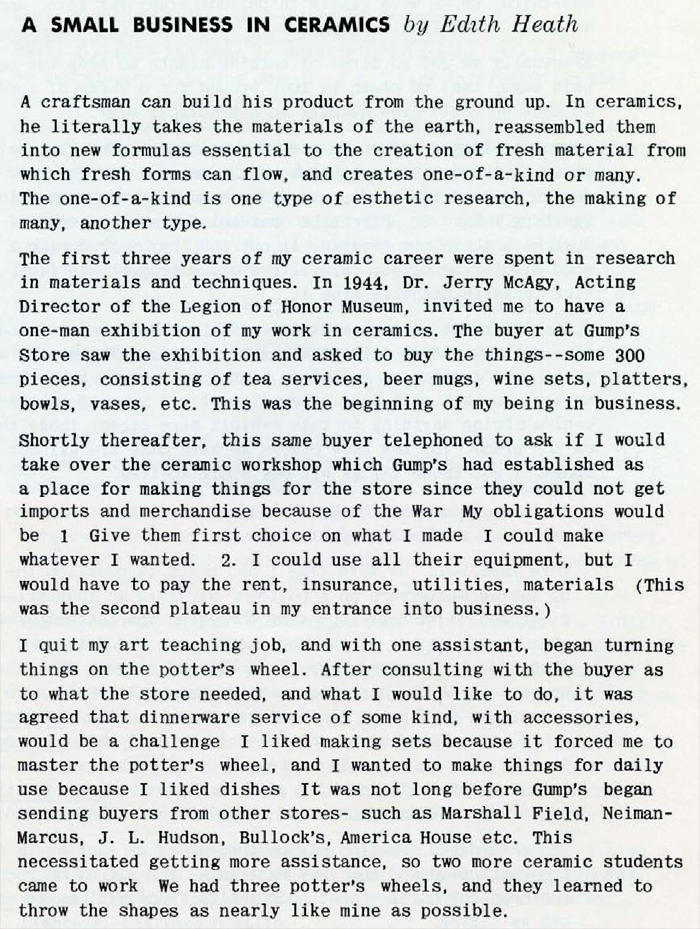Edith Heath / Oakland Museum of California Art
Edith Heath: A Life in Clay at the Oakland Museum of California Art
"This is not a traditional ceramics or craft exhibition - it combines historic objects, photographs, documentary video and personal memorabilia to showcase Heath's legacy and story."
Edith Kiertzner grew up on a farm in Iowa. On the left is the French porcelain china her Danish immigrant parents rarely used.
In 1931 Edith attended Chicago Normal School (Chicago Teachers College) and graduated in 1934. She then went to the Art Institute of Chicago and studied with László Moholy-Nagy at his Chicago School of Design.
She met Brian Heath in 1938 at a summer camp in Batavia, Illinois where they were both working. They soom married and moved to Chicago. In 1941 they moved to San Francisco. Edith taught art at Presidio Hill School and audited classes at California School of Fine Arts. She then enrolled in ceramics and chemistry courses at the San Francisco Art Institute and UC Berkeley. She was working diligently on creating her own clay body.
In 1944 Brian and Edith started Heath Ceramics. Edith worked on design, clay formulation and glazes. Brian managed the business side of the operation.
Gump's buyer, Bill Brewer, saw Edith's work on display at the California Palace of the Legion of Honor. The contents of the show were consigned to Gump's after the show ended and sold well. Brewer then offered her a space they had been using on Clay St. (no joke) that they had been using to host ceramic workshops. Gump's subsidised the rent on what would be her first studio space outside of her home.
With a thriving business, Heath needed to find ways to increase production over what had been just hand thrown ceramics. Jigger wheels and slip casting began in 1947. This is also when the company moved to a rented factory in Sausalito (perhaps in the same building as Luther Conover). The Heath ashtray, actually designed by Brian, was also born this year. This would become a big money maker for the company.
The comparison between wheel-thrown and production examples in the exhibition were some of my favorite displays.
So much great ephemera.
1959 Sausalito factory designed by Marquis & Stoller, in collaboration with Edith.
Edith was even credited on the rendering.
1959 is also when Heath began producing tile.
Hi Maz.
The exhibition recreated the cover of House Beautiful that included Heath ceramics.
However....
Where is the VKG??
I picked up Edith Heath: Philosophies at the exhibition.
This is the most comprehensive resource on Edith and her company. There are so many photos of Edith and related subjects that I've never seen before.
It's also jam-packed with ephemera.
There are a number of great contributors to the book, including JC Miller, who wrote Making a Place for Art: Collaboration between Edith Heath and Robert Royston (see this post). In his section of the book, JC discusses collaborations between Heath and Royston.
Edith collaborated with Royston in the design of the exterior spaces of her and Brian's house, known as The Barge.
Edith and Brian on their Barge.
This exhibition and book are so good. The amount of material presented is beyond impressive. Edith deserves so much credit, first for her work, but also for saving everything. I've heard so many horror stories of company and personal archives being tossed in dumpsters.
Environmental Design Archives at UC Berkeley, The Brian & Edith Heath Foundation, and Heath Ceramics should also be commended for being stewards of the Heath archives and making this exhibition happen.


































